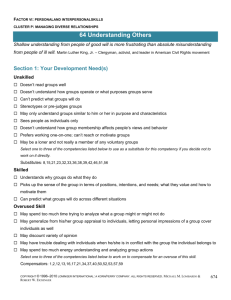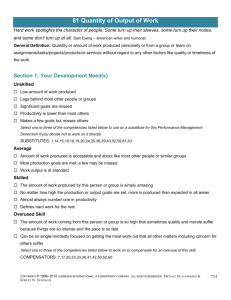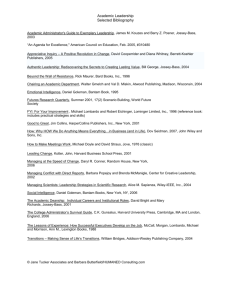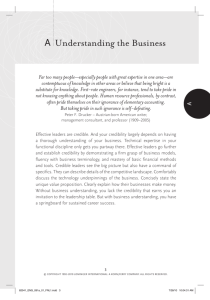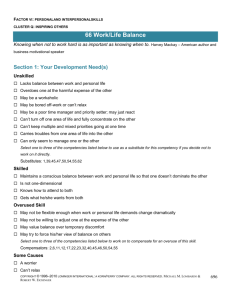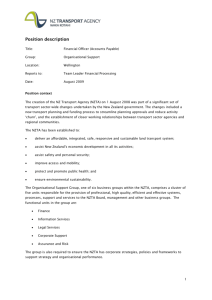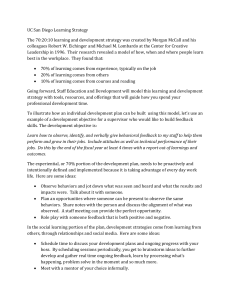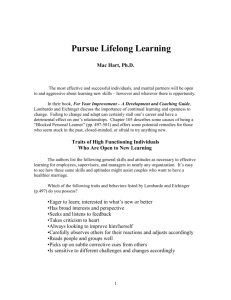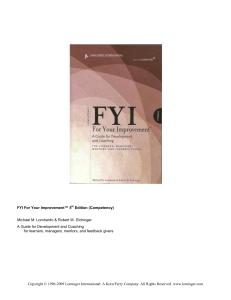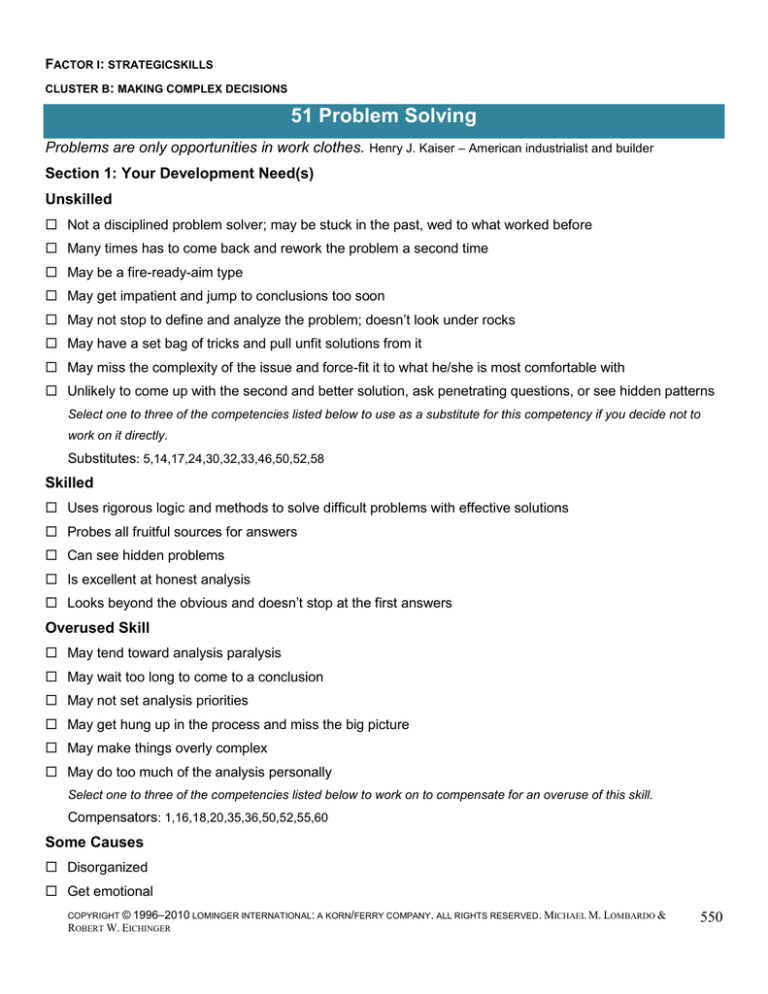
FACTOR I: STRATEGICSKILLS
CLUSTER B: MAKING COMPLEX DECISIONS
51 Problem Solving
Problems are only opportunities in work clothes. Henry J. Kaiser – American industrialist and builder
Section 1: Your Development Need(s)
Unskilled
Not a disciplined problem solver; may be stuck in the past, wed to what worked before
Many times has to come back and rework the problem a second time
May be a fire-ready-aim type
May get impatient and jump to conclusions too soon
May not stop to define and analyze the problem; doesn’t look under rocks
May have a set bag of tricks and pull unfit solutions from it
May miss the complexity of the issue and force-fit it to what he/she is most comfortable with
Unlikely to come up with the second and better solution, ask penetrating questions, or see hidden patterns
Select one to three of the competencies listed below to use as a substitute for this competency if you decide not to
work on it directly.
Substitutes: 5,14,17,24,30,32,33,46,50,52,58
Skilled
Uses rigorous logic and methods to solve difficult problems with effective solutions
Probes all fruitful sources for answers
Can see hidden problems
Is excellent at honest analysis
Looks beyond the obvious and doesn’t stop at the first answers
Overused Skill
May tend toward analysis paralysis
May wait too long to come to a conclusion
May not set analysis priorities
May get hung up in the process and miss the big picture
May make things overly complex
May do too much of the analysis personally
Select one to three of the competencies listed below to work on to compensate for an overuse of this skill.
Compensators: 1,16,18,20,35,36,50,52,55,60
Some Causes
Disorganized
Get emotional
COPYRIGHT © 1996–2010 LOMINGER INTERNATIONAL: A KORN/FERRY COMPANY. ALL RIGHTS RESERVED. MICHAEL M. LOMBARDO &
ROBERT W. EICHINGER
550
Impatient
Jump to conclusions
Perfectionist, need too much data
Rely too much on historical solutions
Leadership Architect® Factors and Clusters
This competency is in the Strategic Skills Factor (I). This competency is in the Making Complex Decisions
Cluster (B) with: 17, 30, 32. You may want to check other competencies in the same Factor/Cluster for related
tips.
The Map
Most people are smart enough to solve problems effectively. Most people know how. Most people don’t do it
right, however. They don’t define the problem and jump to conclusions, or they go to the other extreme and
analyze it to death without trying out anything. They also rely too much on themselves when multiple people
usually have a better chance of solving the problem.
Section 2: Learning on Your Own
These self-development remedies will help you build your skill(s).
Some Remedies
1. Where to start? Define the problem. Instant and early conclusions, solutions, statements, suggestions,
how we solved it in the past, are the enemies of good problem solving. Studies show that defining the
problem and taking action occur almost simultaneously for most people, so the more effort you put on the
front end, the easier it is to come up with a good solution. Stop and first define what the problem is and
isn’t. Since providing solutions is so easy for everyone, it would be nice if they were offering solutions to the
right problem. Figure out what causes it. Keep asking why, see how many causes you can come up with
and how many organizing buckets you can put them in. This increases the chance of a better solution
because you can see more connections. Be a chess master. Chess masters recognize thousands of
patterns of chess pieces. Look for patterns in data; don’t just collect information. Put it in categories that
make sense to you. Ask lots of questions. Allot at least 50% of the time to defining the problem.
2. Results driven? Show some patience. The style that chills sound problem solving the most is the
results-driven, time-short and impatient person. He/she does not take the time to define problems and
tends to take the first close-enough solution that comes along. Studies have shown that on average, the
solution somewhere between the second and third one generated is the best. Impatient people don’t wait
COPYRIGHT © 1996–2010 LOMINGER INTERNATIONAL: A KORN/FERRY COMPANY. ALL RIGHTS RESERVED. MICHAEL M. LOMBARDO &
ROBERT W. EICHINGER
551
that long. Slow down. Discipline yourself to pause for enough time to define the problem better and always
think of three solutions before you pick one.
3. Already made up your mind? Steer clear of biases. Some people have solutions in search of
problems. They have favorite solutions. They have biases. They have universal solutions to most
situations. They pre-judge what the problem is without stopping to consider the nuances of this specific
problem. Do honest and open analysis first. Did you state as facts things that are really assumptions or
opinions? Are you sure these assertions are facts? Did you generalize from a single example? One of your
solutions may in fact fit, but wait to see if you’re right about the problem. More help? – Read Six Thinking
Hats by Edward de Bono.
4. Always use the same solution? Get out of your comfort zone. Many busy people rely too much on
solutions from their own history. They rely on what has happened to them in the past. They see sameness
in problems that isn’t there. Beware of ―I have always…‖ or ―Usually I….‖ Always pause and look under
rocks and ask yourself, Is this really like the problems I have solved in the past?
5. Too self-reliant? Ask others for input. Many try to do too much themselves. They don’t delegate,
listen or ask others for input. Even if you think you have the solution, ask some others for input just to make
sure. Access your network. Find someone who makes a good sounding board and talk to her/him, not just
for ideas, but to increase your understanding of the problem. Or do it more formally. Set up a competition
between two teams, both acting as your advisors. Call a problem-solving meeting and give the group two
hours to come up with something that will at least be tried. Find a buddy group in another function or
organization that faces the same or a similar problem and both of you experiment.
6. Perfectionist? Balance perfection with action. Need or prefer or want to be 100% sure? Want to wait
for all of the information to come in. Lots might prefer that. Beware of analysis paralysis. A good rule of
thumb is to analyze patterns and causes to come up with alternatives. Many of us just collect data, which
numerous studies show increases our confidence but doesn’t increase decision accuracy. Perfectionism is
tough to let go of because most people see it as a positive trait for them. Recognize your perfectionism for
what it might be—collecting more information than others do to improve your confidence in making a faultfree decision and thereby avoiding risk and criticism. Try to decrease your need for data and your need to
be right all the time slightly every week until you reach a more reasonable balance between thinking it
through and taking action.
7. Overwhelmed? Break it down. Sometimes the key to bigger problem solving is to make them into a
series of smaller problems. People who are good at this are incrementalists. They make a series of smaller
COPYRIGHT © 1996–2010 LOMINGER INTERNATIONAL: A KORN/FERRY COMPANY. ALL RIGHTS RESERVED. MICHAEL M. LOMBARDO &
ROBERT W. EICHINGER
552
decisions, get instant feedback, correct the course, get a little more data, move forward a little more, until
the bigger problem is under control. They don’t try to get it right the first time. Learn to break down
problems into pieces and parts and solve them one at a time.
8. Need a new approach? Learn more problem-solving skills. There are many different ways to think
through and solve a problem.
Ask more questions. In one study of problem solving, 7% of comments were ––questions and about half
were answers. We jump to solutions based on what has worked in the past.
To get fresh ideas, don’t speedboat, look deeply instead. Tackle the most ––vexing problem of your job—
carve out 20% of your time—study it deeply, talk with others, look for parallels in other organizations and in
remote areas totally outside your field.
Complex problems are hard to visualize. They tend to be either oversimplified ––or too complex to solve
unless they are put in a visual format. Cut the problem up into its component pieces. Examine the pieces to
see if a different order would help, or how you could combine three pieces into one.
Another technique is a pictorial chart called a storyboard where a problem is ––illustrated by its
components being depicted as pictures.
A variation of this is to tell stories that illustrate the +’s and –’s of a problem, ––then flow chart those
according to what’s working and not working. Another is a fishbone diagram used in Total Quality
Management.
Sometimes going to extremes helps. Adding every condition, every worse ––case you can think of
sometimes will suggest a different solution. Taking the present state of affairs and projecting into the future
may indicate how and where the system will break down.
Are you or others avoiding making the tough points? In almost any group, there ––are topics so hot they
can’t be mentioned, let alone discussed. A technique, pioneered by Chris Argyris, can bubble them to the
surface. Everyone takes three index cards and writes down three undiscussables. (Names are not used;
the assumption is that the position has an effect on behavior, and even if people think the issue is personal,
they are asked to see it in system or group terms.) The cards are then shuffled and each person receives a
different three back. The cards are read, charted, and themes are arrayed for discussion. For more
techniques, read The Art of Problem Solving by Russell Ackoff and Lateral Thinking by Edward de Bono.
9. Avoiding risks? Take calculated risks. Develop a philosophical stance toward mistakes and failures in
problem solving. After all, most innovations fail, most proposals fail, most change efforts fail, and the initial
solutions to complex problems do not work. The best tack when a solution doesn’t work is to say, ―What
can we learn from this?‖ and move on. The more tries, the more feedback and the more chances to find the
best answer. More help? – See #2 Dealing with Ambiguity.
COPYRIGHT © 1996–2010 LOMINGER INTERNATIONAL: A KORN/FERRY COMPANY. ALL RIGHTS RESERVED. MICHAEL M. LOMBARDO &
ROBERT W. EICHINGER
553
10. Disorganized? Get organized. Problem solving involves using rigorous logic and disciplined methods.
It involves going through checklists, looking under rocks, and probing all fruitful sources for answers. If
you’re disorganized, you need to set tight priorities. Focus on the mission-critical few. Don’t get diverted by
trivia. More help? – See #47 Planning and #50 Priority Setting.
Section 3: Learning from Feedback
These sources would give you the most accurate and detailed feedback on your skill(s).
1. Direct Boss
Your direct boss has important information about you, your performance, and your prospects. The
challenge is to get this information. There are formal processes (e.g., performance appraisals). There are
day-to-day opportunities. To help, signal your boss that you want and can handle direct and timely
feedback. Many bosses have trouble giving feedback, so you will have to work at it over a period of time.
2. Natural Mentors
Natural mentors have a special relationship with you and are interested in your success and your future.
Since they are usually not in your direct chain of com-mand, you can have more open, relaxed, and fruitful
discussions about yourself and your career prospects. They can be a very important source for candid or
critical feedback others may not give you.
3. Past Associates/Constituencies
When confronted with a present performance problem, some claim, ―I wasn’t like that before; it must be the
current situation.‖ When feedback is available from former associates, about 50% support that claim. In the
other half of the cases, the people were like that before and probably didn’t know it. It sometimes makes
sense to access the past to clearly see the present.
Section 4: Learning from Develop-in-Place Assignments
These part-time develop-in-place assignments will help you build your skill(s).
Integrate diverse systems, processes, or procedures across decentralized and/or dispersed units.
Plan a new site for a building (plant, field office, headquarters, etc.).
Study the history of a similar situation and draw parallels for a current business issue or problem, and
present your findings to others for comment.
Relaunch an existing product or service that’s not doing well.
Manage a group of people who are towering experts but you are not.
Assemble a team of diverse people to accomplish a difficult task.
Handle a tough negotiation with an internal or external client or customer.
COPYRIGHT © 1996–2010 LOMINGER INTERNATIONAL: A KORN/FERRY COMPANY. ALL RIGHTS RESERVED. MICHAEL M. LOMBARDO &
ROBERT W. EICHINGER
554
Take on a tough and undoable project, one where others who have tried it have failed.
Resolve an issue in conflict between two people, units, geographies, functions, etc.
Audit cost overruns to assess the problem, and present your findings to the person or people involved.
Section 5: Learning from Full-Time Jobs
These full-time jobs offer the opportunity to build your skill(s).
1. Change Manager
The core demands to qualify as a Change Manager are: (1) Leader of a significant effort to change
something or implement something of significance. (2) Success and failure will be evident. (3) Always
something new and unique to the organi-zation. (4) Must get many others to buy in and cooperate. (5)
Involves cross-boundary change. (6) High visibility sponsor. (7) Exposure to significant decision makers
and key stakeholders. (8) Resistance is expected and near-universal. (9) Cost of failure is significant.
Examples include: (1) Total Work Systems like TQM, ISO, or Six Sigma. (2) Business restructurings like a
move away from a core competence and into a new product space or industry, i.e., American carmakers
move into smaller, more fuel-efficient products. (3) Installing major systems (like an ERP or HRIS) and
procedures for the first time. (4) M&A integrations, responding to major competitor initiatives that threaten
the organization. (5) Extensive reorganizations. (6) Long-term post-corporate scandal recovery.
2. Crisis Manager
The core demands to qualify as Crisis Manager are: (1) Leader responsible for an unpredictable, unique
crisis of significant proportion. (2) Success and failure will be evident and visible. (3) Takes Herculean effort
to solve. (4) Learning something on the fly. (5) Solution requires cross-boundary team. (6) Leader will be a
spokesperson and potentially subjected to media scrutiny. (7) Hostile questioning and suspicious
atmosphere is common. (8) Time pressure is extreme. (9) Solution involves working with parties outside
the organization. (10) Usually short-term (up to three months). (11) Other parts of job would have to be
temporarily set aside. Examples of crisis management would be: (1) A product safety recall; product or
system failure. (2) Unexpected death of a CEO or senior corporate executive. (3) Unexpected termination
or scandal involving a CEO or senior corporate executive. (4) Trouble with a key customer or supplier that
decreases revenue or production. (5) Natural disasters. (6) Terrorist attacks. (7) Kidnapping or arrest of
employees; violent crime against employees.
3. Heavy Strategic Demands
The core demands necessary to qualify as a Heavy Strategic Demands assignment are: (1) Requires
significant strategic thinking and planning most couldn’t do. (2) Charts new ground strategically. (3) Plan
must be presented, challenged, adopted, and implemented. (4) Exposure to significant decision makers
COPYRIGHT © 1996–2010 LOMINGER INTERNATIONAL: A KORN/FERRY COMPANY. ALL RIGHTS RESERVED. MICHAEL M. LOMBARDO &
ROBERT W. EICHINGER
555
and executives. Examples of jobs with Heavy Strategic Demands: (1) Strategic planning position. (2) Job
involving repositioning of a product, service, or organization.
4. Scope Assignments
The core demands for a Scope (complexity) assignment are: (1) Significant in-crease in both internal and
external scope or complexity. (2) Significant increase in visibility and/or bottom-line responsibility. (3)
Unfamiliar area, business, technol-ogy, or territory. Examples of Scope assignments involving shifts: (1)
Switching to new function/technology/business. (2) Moving to new organization. (3) Moving to overseas
assignment. (4) Moving to new location. (5) Adding new products/services. (6) Moving between
headquarters/field. (7) Switches in ownership/top management of the unit/organization. Examples of Scope
assignments involving ―firsts‖: (1) First-time manager. (2) First-time managing managers. (3) First-time
executive. (4) First-time overseas. (5) First-time headquarters/field. (6) First-time team leader. (7) First-time
new technology/business/function. Scope assignments involving increased complexity: (1) Managing a
significant expansion of an existing product or service. (2) Managing adding new products/services into an
existing unit. (3) Managing a reorganized and more diverse unit. (4) Managing explosive growth. (5) Adding
new technologies.
5. Small Entrepreneurial
The core demands for qualifying as a Small Entrepreneurial assignment are: (1) Founder or core team
member of a company or brand. (2) Personal financial stake in the business’s success or failure. (3)
Success and failure will be evident. (4) Build business case and secure funding from investors. (5) Chart
new market strategy for new product line. (6) Manage all aspects of the business—from product
design/development, supply chain, marketing, sales, finance, HR. Examples of Small Entrepreneurial jobs
would be: (1) Small business owner. (2) Among the first employees of a growing company. (3) Starting an
incubator business or a new business line. (4) Launching a new brand or new product line. (5) Entering a
new market. (6) Responsible for a new product/system through entire cycle.
Section 6: Learning from Your Plan
These additional remedies will help make this development plan more effective for you.
Learning to Learn Better
1. Find a Parallel to the Current Problem and Learn from It
Find a parallel with similar situations, whether in your field or in other areas, past or present, and look for
comparison or contrast points to see what else has or hasn’t worked. Search especially for the reasons
why certain things work and others don’t across different situations; find the common and uncommon
elements.
COPYRIGHT © 1996–2010 LOMINGER INTERNATIONAL: A KORN/FERRY COMPANY. ALL RIGHTS RESERVED. MICHAEL M. LOMBARDO &
ROBERT W. EICHINGER
556
2. Keep a Rule of Thumb Journal
In a journal, record your new knowledge and lessons, add to your rules of thumb, or revise old rules that no
longer apply. Constantly assess the accuracy of your accumulated lessons; don’t allow yourself to lapse
into ―autopilot.‖
3. Analyze Your Past Successes for Insights and Learnings
Look at your accomplishments in detail. Ask why they came off well. What did you do that directly led to
positive outcomes? Are they repeatable in other situations? How much was attributable to the context itself,
how much to the work of others, and how much to you? Was it a windfall win? What lessons and rules of
thumb can you take away from these successes?
4. Look Beyond Your First Solution to a Problem
Don’t always take the first action you think of. Look further for a second and third: What’s different? Might
the second or third be more effective? Research shows that the best solution lies somewhere between the
second and third strategies or approaches. Your first solution is often an ―autopilot‖ response and may not
be the best.
5. Break Up Your Work Routine When You’re Blocked
When blocked on a problem, intersperse your work routine with dissimilar tasks, activities, or rest breaks.
Turn to another task for a while. In a sequence of tough work, string dissimilar tasks together so you can
vary the types of skills used and the work done.
6. Become a Student of How People Learn
Become a student of learning: Read some books and articles on child and adult learning; read about how
the brain and mind work; study diverse learners of the past for insights; study the teaching techniques of
expert teachers and coaches; attend a course on instructional design. Write and deliver a presentation on
your findings.
7. Try New Things, Take Some Chances, Increase Personal Risk-Taking
Engage in some creative problem-solving activities such as brainstorming, free association, analogies to
unrelated areas, nominal group techniques, etc. Let yourself go; let your thinking flow freely. Break down
the restrictions on yourself; break through old barriers and blockages; try new ways of thinking.
COPYRIGHT © 1996–2010 LOMINGER INTERNATIONAL: A KORN/FERRY COMPANY. ALL RIGHTS RESERVED. MICHAEL M. LOMBARDO &
ROBERT W. EICHINGER
557
8. Study Something Unusual or Unexpected
Consider the odd and unusual facts or opinions that don’t seem to fit in anywhere. If these anomalies
comprised the majority opinion, where would that lead? What beliefs or facts would you have to have to
state those unusual opinions?
Learning from Experience, Feedback, and Other People
9. Learning from Interviewing Others
Interview others. Ask not only what they do, but how and why they do it. What do they think are the rules of
thumb they are following? Where did they learn the behaviors? How do they keep them current? How do
they monitor the effect they have on others?
10. Learning from Mistakes
Since we’re human, we all make mistakes. The key is to focus on why you made the mistake. Spend more
time locating causes and less worrying about the effects. Check how you react to mistakes. How much
time do you spend being angry with yourself? Do you waste time stewing or do you move on? More
importantly, do you learn? Ask why you made the mistake. Are you likely to repeat it under similar
situations? Was it a lack of skill? Judgment? Style? Not enough data? Reading people? Misreading the
challenge? Misreading the politics? Or was it just random? A good strategy that just didn’t work? Others
who let you down? The key is to avoid two common reactions to your mistakes: (1) avoiding similar
situations instead of learning and trying again, and (2) trying to repeat what you did, only more diligently
and harder, hoping to break through the problem, yet making the same mistake again and with greater
impact. Neither trap leaves us with better strategies for the future. Neither is a learning strategy. To learn to
do something differently, focus on the patterns in your behavior that get you in trouble and go back to first
causes, those that tell you something about your shortcomings. Facing ourselves squarely is always the
best way to learn.
Problems are to the mind what exercise is to the muscles, they toughen and make strong. Norman
Vincent Peale – American preacher and author
COPYRIGHT © 1996–2010 LOMINGER INTERNATIONAL: A KORN/FERRY COMPANY. ALL RIGHTS RESERVED. MICHAEL M. LOMBARDO &
ROBERT W. EICHINGER
558
Suggested Readings
Ben, D. (2002). Advantage play: The manager‘s guide to creative problem solving. Toronto: Key Porter Books.
Couzins, M., & Beagrie, S. (2003). How to…be an effective problem solver. Personnel Today. Retrieved July
16, 2008, from www.personneltoday.com/goto/20616.
Davidson, J. E., & Sternberg, R. J. (Eds.). (2003). The psychology of problem solving. New York: Cambridge
University Press.
Dotlich, D. L., Cairo, P. C., & Rhinesmith, S. H. (2009). Complexity and uncertainty: How to lead in turbulent
times. San Francisco: Jossey-Bass.
Haines, S. G. (2006). The top 10 everyday tools for daily problem solving: Strategic thinking handbook #1. San
Diego: Systems Thinking Press.
Hoenig, C. W. (2000). The problem-solving journey: Your guide for making decisions and getting results.
Cambridge, MA: Perseus Publishing.
Kourdi, J. (2007). Think on your feet: 10 Steps to better decision making and problem solving at work. London:
Cyan Communications.
Nalebuff, B. J., & Ayers, I. (2003). Why not? How to use everyday ingenuity to solve problems big and small.
Boston: Harvard Business School Press.
Roam, D. (2008). The back of the napkin: Solving problems and selling ideas with pictures. New York:
Portfolio.
Robson, M. (2002). Problem-solving in groups. Hampshire, UK: Gower Publishing Limited.
Rosenhead, J., & Mingers, J. (2001). Rational analysis for a problematic world: Problem structuring methods
for complexity, uncertainty and conflict. West Sussex, England: John Wiley & Sons, Ltd.
Straus, D. (2002). How to make collaboration work: Powerful ways to build consensus, solve problems, and
make decisions. San Francisco: Berrett-Koehler Publishers.
Vaughn, R. H. (2007). Decision making and problem solving in management. Brunswick, OH: Crown Custom
Publishing.
White, S. P. (with Patton Wright, G.). (2002). New ideas about new ideas: Insights on creativity with the world‘s
leading innovators. Cambridge, MA: Perseus Publishing.
COPYRIGHT © 1996–2010 LOMINGER INTERNATIONAL: A KORN/FERRY COMPANY. ALL RIGHTS RESERVED. MICHAEL M. LOMBARDO &
ROBERT W. EICHINGER
559

